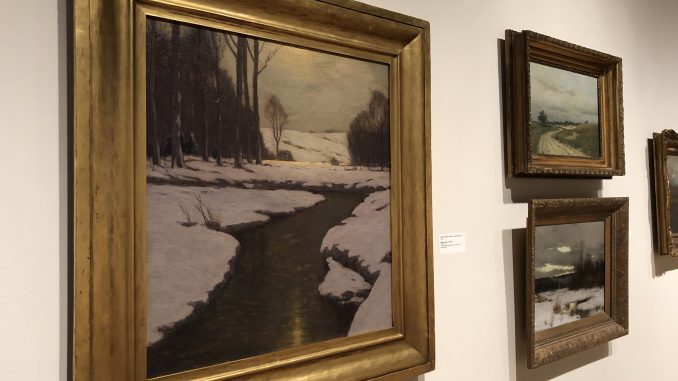
Visiting the Dorsky Museum this semester will take you on a transcontinental trip across the globe!
Current exhibitions range from the mid 20th century Italian Arte Povera movement (“Paper Media: Boetti, Calzolari, Kounellis”) and 19th century Edo period Japanese woodblock prints (“The Ukiyo-e Movement”) to works with connections right here in the Hudson Valley (“Tonalism: Pathway from the Hudson River School to Modern Art”)—The Dorsky offers something for everyone.
Upon first entering the museum in the Morgan Anderson Gallery, a visitor is greeted with the tonalism exhibit; a seemingly endless array of beautiful landscape paintings. This exhibition may seem simple at first and may not be initially captivating beyond its collection of large, period-esque gold frames, but upon further viewing and understanding of the Tonalist movement, one finds that there is more than meets the eye.
This sentiment was literally felt by museum visitor and SUNY New Paltz alumna, Andrea Cohen (‘73). The piece “Woman by a River,” (1904) by Agnes Richmond, became an immersive experience for her.
“I could feel my eyes adjusting as though I were really in a dark room,” Cohen said.
The painting depicts a woman dressed in white, at first difficult to see due to the muted, dark colors surrounding her.
The piece speaks to the goal of tonalist artists which was not to capture a specific subject or landscape but rather to evoke a certain mood in the viewer.
“[It] essentially [divorces] meaning from the actual elements of the painting,” said Zachary Bowman, manager of education and visitor experience at the museum. “Which is what abstraction was right?”
Abstractionism extends throughout the museum’s exhibitions. Notably in the piece “Segnali [Signals],” (1960) by Jannis Kounellis found in the “Paper Media: Boetti, Calzolari, Kounellis” exhibit in the Sara Bedrick Gallery. This piece can at first be mistaken for a math equation, composed simply of the number 33, four small dashes, a plus and a multiplication sign painted onto a white background.
“[The artist] was really interested in how signs and symbols might sort of be taken out of context and represent nothing,” Bowman said. “There’s this idea of nothingness that kind of fits into this idea of anti-commodity.”
The exhibit celebrates the Arte Povera, “poor art,” movement in Italy. Lasting from 1967 to 1972, the primary purpose of the movement was to reject commodification and to use everyday materials in art.
Although an interesting and informative show, the work starts to lose its meaning in the simple frames and tidy structure of the Dorsky. Originally exhibited in Magazzino Italian Art, the curators there had live parrots, donkeys, and sacks of grain on the ground to bring the narrative of the movement to life.
Finally in the seminar room, the Dorsky displays “The Ukiyo-e Movement,” a collection of Japanese woodblock prints spanning one hundred years from 1750 to 1850. “Ukiyo-e” means “pictures from the floating world,” often these prints depict figures who “float” with no clear background or horizon line.
The prints in this collection are simply stunning, including works from Katsushika Hokusai— “one of the most famous artists in the world that people don’t know,” Bowman said. Hokusai was the artist behind “The Great Wave off Kanagawa,” 1829- 1833.
The fact that Hokusai is not a readily recognizable name speaks to the reason why Bowman appreciates having these works on display.
“The excellent thing about seeing work, especially from Asia, is that [usually it’s] art of the western world right?” Bowman said. “When you’re taking [an] art history class, you’re learning the history of white Europeans and then white Americans so it’s nice to have that history expanded on.”
All three exhibits are on display now until Dec. 8. The Dorsky Museum is open Wednesday through Sunday, 11 a.m. to 5 p.m.
